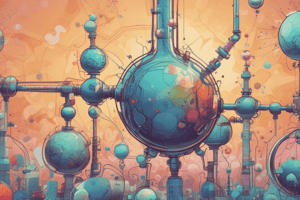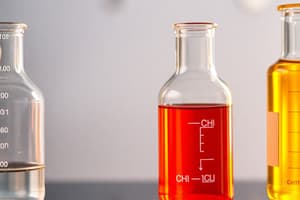Podcast
Questions and Answers
What is the primary effect of a catalyst on a chemical reaction?
What is the primary effect of a catalyst on a chemical reaction?
- Lowers the activation energy for the reaction (correct)
- Modifies the thermodynamics of the reaction
- Alters the equilibrium compositions of the reactants and products
- Changes the yield and purity of the products
What is a catalyst in the context of catalysis?
What is a catalyst in the context of catalysis?
- A material that alters the thermodynamics of a reaction
- An element that changes the equilibrium compositions of a chemical system
- A foreign material that speeds up a reaction without being substantially consumed (correct)
- A substance that consumes reactants in a chemical reaction
How does catalysis contribute to sustainability?
How does catalysis contribute to sustainability?
- By increasing the activation energy of chemical reactions
- By slowing down the rate of chemical reactions
- By generating large amounts of side products and waste
- By reducing the necessity of dangerous and expensive chemicals (correct)
What characteristic of a catalyst allows it to be used in small amounts relative to the substrate?
What characteristic of a catalyst allows it to be used in small amounts relative to the substrate?
How does a catalyst affect the rate of a chemical reaction?
How does a catalyst affect the rate of a chemical reaction?
Flashcards are hidden until you start studying
Study Notes
Catalysts and Catalysis
- A catalyst is a substance that speeds up a chemical reaction without being consumed or altered in the process.
- The primary effect of a catalyst on a chemical reaction is to lower the activation energy, allowing the reaction to occur faster and more efficiently.
- Catalysis contributes to sustainability by reducing the amount of energy required for a reaction, thus minimizing waste and environmental impact.
Characteristics of Catalysts
- A catalyst can be used in small amounts relative to the substrate because it is not consumed during the reaction and can be recovered and reused.
- This characteristic of a catalyst is known as its turnover number, which represents the number of substrate molecules that can be converted by a single catalyst molecule.
Catalysts and Reaction Rate
- A catalyst affects the rate of a chemical reaction by providing an alternative reaction pathway with a lower activation energy, allowing more reactant molecules to react in a given time.
- The presence of a catalyst increases the frequency of successful collisions between reactant molecules, leading to a faster reaction rate.
Studying That Suits You
Use AI to generate personalized quizzes and flashcards to suit your learning preferences.




